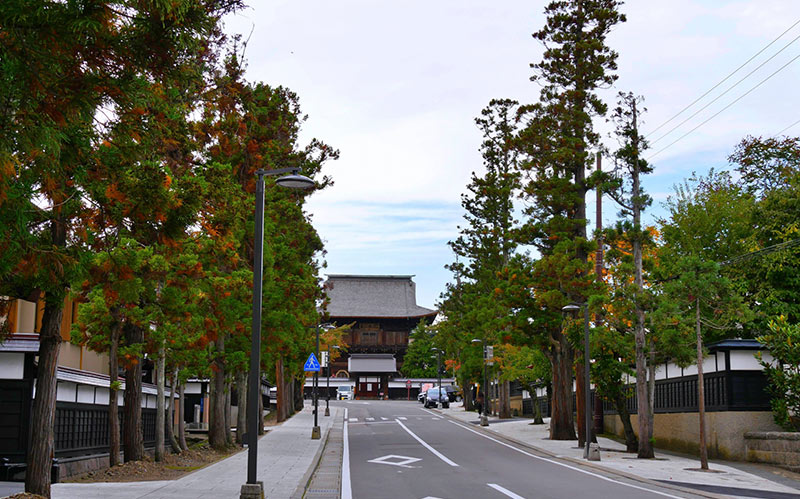- The construction of Hirosaki Castle and the “Zenrin Area” that accompanied it
- Choshoji Temple, which became a family temple of the Hirosaki Domain, with gravesites of successive domain lords, including Nobumaki, the second lord of the domain.
- The discovery of the mummy of Tsugaru Seisuke during the relocation of the cemetery at Choshoji Temple astonishes the public.
- Access to Choshoji Temple
- Parking around Choshoji Temple
- Choshoji Temple Official Website
- Recommended around Chosho-ji Temple
The construction of Hirosaki Castle and the “Zenrin Area” that accompanied it
In the late Warring States Period, Tsugaru Tamenobu, who became independent from the Nanbu clan and took control of the Tsugaru Plain, decided to build a new castle and move from Horikoshi Castle, where he had been based. This was because he judged Horikoshi Castle to be militarily unsuitable.
Tamenobu’s attention was drawn to the Takanoaka area, and in 1603, Tsugaru Tamenobu began construction of a castle at Takanoakaoka.
In 1584, Tsugaru Tamenobu renovated Horikoshi Castle and moved his residence from Oura Castle. After that, the castle remained the residence of the Tsugaru clan until Hirosaki Castle was built, but when Tame-nobu died a guest in Kyoto the following year, the business was taken over by the second lord of the domain, Tsugaru Nobumaki.
Nobumaki proceeded with the construction of the castle at a rapid pace, using materials from Horikoshi Castle and Oura Castle. One year and one month after resuming construction, Takaoka Castle was completed. The name of the castle was later changed to Hirosaki Castle.
In 1610, Nobumaki moved his family temple, Chosho-ji Temple, from Tanezato in parallel with the construction of Hirosaki Castle.
Thirty-three temples of the Soto sect were gathered in the southern part of Hirosaki Castle where Chosho-ji Temple was relocated. The area became known as “Zenrin-gai” (Zen Forest Street) because of the rows of temples along the tree-lined avenues.
Choshoji Temple, which became a family temple of the Hirosaki Domain, with gravesites of successive domain lords, including Nobumaki, the second lord of the domain.
Choshoji Temple was built in 1528 during the Warring States Period in Tanezato, which was then the home of the Oura clan, to mourn their loss.
The Oura clan rapidly expanded its power during the reign of Tame-nobu.
When Tame-nobu moved his headquarters to Oura, Chosho-ji Temple was also moved to Oura.
When Nobumaki completed Hirosaki Castle in 1611, Chosho-ji Temple was moved to the southwest, the back gate of the castle.
Chosho-ji Temple and the rest of the Zenrin Street were separated from the castle town of Hirosaki by moats, cliffs, and low marshy areas, so they could be expected to function as a filling station for Hirosaki Castle.
The Tsugaru clan had an acrimonious relationship with the neighboring Nanbu clan, so perhaps they were conscious of the need to build a castle town that would be practical in battle.

The discovery of the mummy of Tsugaru Seisuke during the relocation of the cemetery at Choshoji Temple astonishes the public.
Chosho-ji Temple, the family temple of the Tsugaru Clan, is where successive feudal lords and people close to the feudal lords are buried.
In 1954, when the cemetery of Chosho-ji Temple was to be relocated, surveys and construction work were conducted.
At that time, a body was found buried in a coffin lined with tea husks 7 meters underground in the cemetery.
The body was identified as that of Tsugaru Seisuke, who died in 1855 at the age of 18.
The body was found in a state of mummified dead wax that had escaped decomposition, much to the surprise of the finder.
The body was not exposed to the outside air, and the decomposing bacteria did not grow, so the entire corpse became wax-like.
After an academic investigation, the body was cremated and reburied at the request of the Tsugaru family.
Access to Choshoji Temple
1-13-8 Nishimomori, Hirosaki-shi, Aomori 036-8273
Parking around Choshoji Temple
Choshoji Temple Official Website
Official site:https://www.hirosaki-kanko.or.jp/en/edit.html?id=edit03
